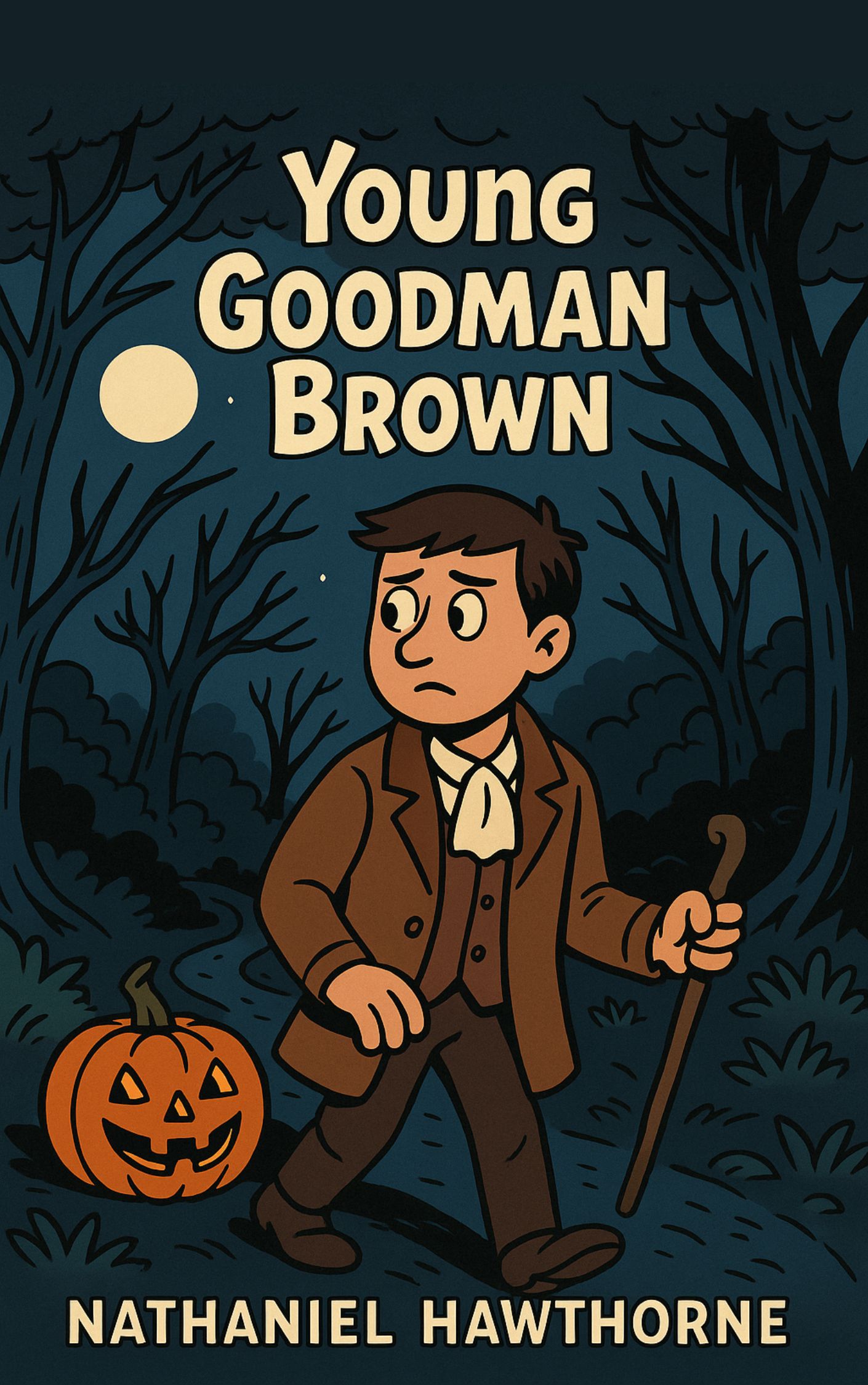Description
Young Goodman Brown is a story that begins in the small town of Salem. A man named Goodman Brown is leaving his house at night, even though his wife, Faith, begs him to stay. Faith, with her pink ribbons and gentle spirit, represents innocence and love. Yet Goodman Brown feels he must go on a secret journey, though we do not know exactly why. He steps into the dark forest, where shadows and strange shapes seem to surround him, and a heavy feeling of danger fills the air.
Not far into the forest, Goodman Brown meets a mysterious traveler. This man looks very much like Goodman Brown himself, but older and more confident. The stranger carries a staff shaped like a snake, which seems almost alive. Their meeting feels unsettling, as though this man has been waiting for him. As they walk together, the older man hints that he knows Goodman Brown’s family well. He claims to have walked with his father and grandfather before, helping them commit violent and cruel acts that clash with their reputation as “good Christians.” Goodman Brown is shaken. He has always believed his family to be pure, honest, and faithful. Now he is forced to question whether they were really as holy as they seemed.
As the two move deeper into the woods, Goodman Brown begins to see people from his own community. These are people he respects: teachers of religion, leaders of prayer, neighbors who appear kind and moral. Yet here in the forest, they act strangely. Goodman Brown sees Goody Cloyse, a woman he knows as a pious Christian. But she greets the older man like an old friend of dark business. When the stranger throws his serpent staff at her feet, she vanishes into the night as though consumed by evil. Goodman Brown hides, horrified, wondering if everything he thought he knew about his community is a lie.
Goodman Brown tries to resist, insisting that his family, his neighbors, and his own heart are better than this. He thinks of his wife, Faith, and feels sure that she is untouched by evil. Yet as the night deepens, he hears familiar voices of respected church members, Deacon Gookin and others, traveling to the same dark gathering. Desperate, he decides he will turn back for Faith’s sake. But in that very moment, he hears her voice among the shadows. Struck with despair, he believes that even his beloved wife has joined the same wicked path.
In a frenzy of hopelessness, Goodman Brown grabs the serpent-like staff and is swept forward, as though carried by unseen powers. He finds himself in a fiery clearing in the woods, where flames light up an unholy ritual. Around him stand countless figures, villagers he knows well: elders, neighbors, leaders, all revealed as worshippers of the Devil. The air is filled with chants, and a dark figure presides over the ceremony. Goodman Brown feels himself drawn into the crowd, bound to them by the evil that lies in every human heart.
Then, he sees Faith among the group of converts. Her ribbons are gone, her innocence now clouded by shadow. Goodman Brown cries out to her to resist, to look toward Heaven and reject this terrible power. In an instant, the entire scene disappears. The forest falls silent. The fire, the people, the voices—all vanish into nothing. Goodman Brown is left alone, unsure of what truly happened.
The next morning, Goodman Brown returns to Salem Village. Everything looks as it always did. The minister walks calmly to his church, preparing his sermon. Deacon Gookin prays in his home. Goody Cloyse teaches a child her catechism. His wife, Faith, greets him joyfully as if nothing has changed. But for Goodman Brown, everything is different. He cannot see these people the same way again. Their words, their smiles, their prayers feel false to him now. Were last night’s visions real, or just a dream? He cannot tell—but it no longer matters.
From that day forward, Goodman Brown becomes a changed man. He lives with suspicion, distrust, and gloom. Every person he meets seems tainted with secret sin. When he goes to church, he hears only lies in the minister’s voice. When he sees neighbors praying, he imagines their hypocrisy. Even with his wife, he feels only doubt and distance. Faith, who once represented love and purity to him, can no longer comfort him. He turns cold, detached, and stern.
The story tells us that Goodman Brown lives the rest of his life in misery. He becomes a man who cannot trust, cannot love, and cannot hope. His view of humanity is shattered, and he cannot rebuild it. Whether the forest vision was real or a dream does not matter—its effect is permanent. He carries that weight until his final days. And when he dies, no words of hope or faith are written on his tombstone. His life ends in the same darkness and despair that consumed him after that fateful night in the forest.
At its heart, Young Goodman Brown is a story about the fragile nature of belief, trust, and innocence. It shows how quickly faith in others can collapse once we see their flaws, and how dangerous it is to hold impossible expectations of purity and perfection. The Puritan world, with its strict codes of morality, leaves no space for human weakness. When Goodman Brown discovers the possibility that sin exists everywhere, even in those he most admires, he cannot handle it. Instead of accepting that people can be both good and bad, he chooses to believe the worst of everyone.
The tragedy of Goodman Brown is not just what he saw in the forest, but how he responded to it. Rather than seeking balance or forgiveness, he chose despair. He let suspicion and judgment rule his heart. And because of this, he lost the ability to live with joy, trust, and love. His story is a reminder that seeing only the darkness in others can leave us blind to the light that still remains.





